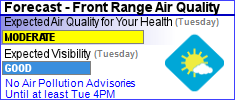2025 Ozone Season Data Shows Improvement From Favorable Meteorology, But Nonattainment Area Continues to Be Out of Compliance
Updated: October 9, 2025Press Release
Media Contact: David Sabados
Communications, Programs, and Government Affairs Director
Regional Air Quality Council
Weather conditions that were less likely to lead to ozone formation this summer resulted in fewer days above the federal ozone standard on Colorado’s Front Range during the summer ozone season in 2025. However, even with favorable meteorology, monitors on the Front Range still recorded 23 days above the federal ozone standards, highlighting a need for continued action to reduce emissions and achieve attainment under Environmental Protection Agency standards. 2025 was the lowest ozone season since 2009.
2025 ozone season: alert days and exceedances
While ozone levels are monitored year-round, most alerts and exceedances occur mid-May through mid-September each year.
The Colorado Department of Public Health and Environment (CDPHE) called a total of 33 Ozone Action Day Alerts in 2025. Alert days are forecast in advance when conditions appear favorable for ground-level ozone formation. However, the ozone level does not always exceed allowed levels on alert days, in part because alerts let people know that their actions on these days can make a difference.
Ozone Action Day Alerts took place on the following timeline in 2025:
- May: Two alerts were issued in May this year, on May 10 and 13. These alerts took place earlier in the year than usual on days when weather conditions were prime for ozone formation from anthropogenic emissions.
- Between May 31 and Aug. 31, the three-month time range when the state of Colorado officially tracks and sends Ozone Action Day Alerts, CDPHE issued 30 alerts.
- September: One alert day took place on Sept. 4, 2025.
A total of 23 days were in exceedance of EPA standards in 2025. Exceedances in 2025:
- Six days exceeded the EPA standard of 75ppb. It is notable that no single monitor recorded more than three exceedances of the 75ppb standard, meaning Colorado was in compliance with the 75ppb standard in 2025. This is the first time Colorado had what’s called a “clean year” for the 75ppb standard since 2017.
- Seventeen days fell in the 70ppb-75ppb range, exceeding the EPA standard of 70ppb. Eight monitors each registered more than three individual exceedance days for the 70ppb standard, which results in Colorado continuing to be out of compliance for the 70ppb standard.
By comparison, in 2024, 41 days exceeded the 70ppb standard. And during 2023, 27 days exceeded the 70ppb standard. Additional data from the 2025 season and previous years’ data can be found on the RAQC website here: https://raqc.org/8-hour-ozone-summary-reports.
What is ground-level ozone, what are the standards, and what role does the RAQC play?
Human-caused emissions—largely from oil and gas operations, gas and diesel-powered vehicles, gas-powered landscape maintenance equipment, other uses of fossil fuels, and other sources such as consumer products—create the ozone precursors Nitrogen Oxides (NOx) and Volatile Organic Compounds (VOCs), which chemically interact with heat and sunshine to produce ground-level ozone. While natural ozone is needed in the upper atmosphere (the ozone layer) to protect the earth from the harmful rays of the sun, ground-level ozone is dangerous for humans, animals, and plants, causing breathing difficulties and other health problems, including long-term chronic health issues, plus crop and ecosystem damage.
Unsafe ozone levels are set by EPA. A 2008 standard of 75ppb was updated in 2015 to 70ppb, and the RAQC works on plans to reduce measured ozone for both standards, as required by the EPA under authority from the federal Clean Air Act.
The Regional Air Quality Council (RAQC) is designated as the lead air quality planning organization for Colorado’s Denver Metro and North Front Range and operates largely in a nine-county region designated as a nonattainment area that is out of compliance with federal standards. In coordination with the Colorado Department of Public Health and Environment (CDPHE), the RAQC develops emission control strategy options and documents expected progress in periodic State Implementation Plans (SIPs), which are plans for how the Front Range can reduce summertime ozone and meet attainment.
What’s next? Planning for the future
The RAQC is in the process of developing a Control Strategy Blueprint of emission control strategy options for the next five years. As part of the Blueprint development process, the RAQC convenes conversations with stakeholders from industry, local government, environmental advocacy groups and interested citizens. The Blueprint is a strategic air quality planning framework for achieving attainment of the federal ozone standards by 2032 throughout the Denver Metro/North Front Range nonattainment area.
The Blueprint is not a binding document, but rather a set of policy recommendations to guide the RAQC’s planning work over the next five years. The RAQC’s Control Strategy Blueprint page has detailed information about the entire Blueprint process, including supporting documents for proposed strategies, stakeholder outreach efforts, and previous versions of the Blueprint and strategy exploration.
While the RAQC’s regulatory efforts span the full nine county region, due to funding restrictions many of RAQC’s effective, voluntary emissions-reducing programs that have a direct impact on reducing ozone precursors have operated in only seven counties. Next year, the RAQC will begin to expand many of its programs throughout the full nine-county ozone nonattainment region, with funding from the Colorado’s Nonattainment Area Air Pollution Mitigation Enterprise. More information on RAQC programs can be found at RAQC.org/programs.
RAQC staff members are available for additional comment or interviews upon request.

